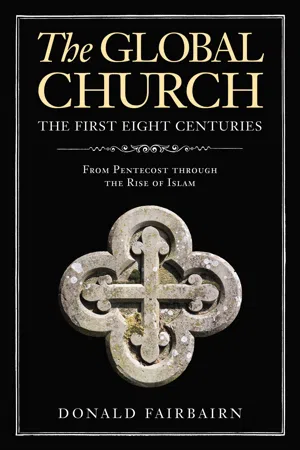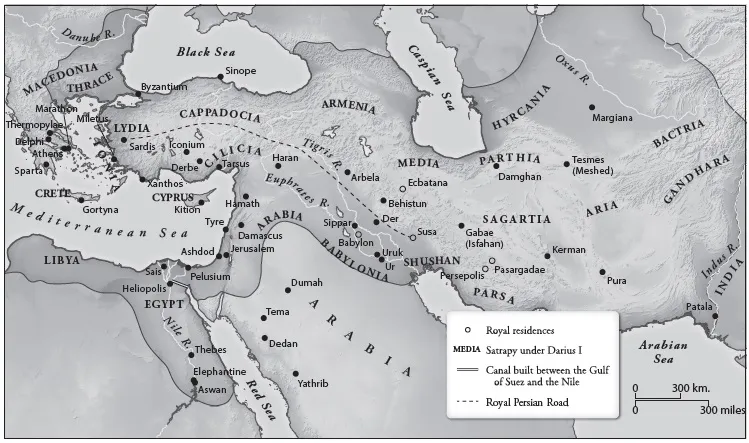Chapter One
IN THE FULLNESS
OF TIME
The World of the First Century
In Galatians 4:4 Paul writes that God sent his Son “when the set time had fully come.” In the context of the biblical passage, the “set time” is the time when an heir’s father gives him his inheritance, prior to which time the heir is under the tutelage of guardians. Paul likens the Jews to the young heir waiting and learning as he looks ahead to adulthood. This depiction of the Jews as sons and heirs should be read in light of God’s much earlier promise to Abram in Genesis 12:3 that “all peoples on earth will be blessed through you.” The promise to Israel was never meant for Jews alone but for the whole people of God (including both Jews and gentiles), and the promise was ultimately fulfilled in the church. As a result, throughout Christian history the “fulness of the time” (as the King James Version memorably renders Galatians 4:4) has commonly been understood as the time when not just the Jews but the world as a whole would be ready for the sending of the Son and God’s adoption of believers as his children/heirs.
Therefore, as we set the stage for early Christian history, we need to reflect briefly on the world in which Jesus and the apostles lived, the world to which the Holy Spirit descended at Pentecost. I will consider not primarily first-century Judaism (a subject which is the purview of books on the background to the New Testament), but the societies of Africa, Asia, and Europe that surrounded the Jews in the first century. I would like to highlight the way the interactions between great empires led to a world with improved transportation and faster communication. I will also accent the way religious ferment in the Eastern Hemisphere, coupled with increasingly widespread contact with the Jewish people, created an environment in which the gospel might gain a hearing.
A WORLD OF INTERACTING EMPIRES
After humanity was scattered over the face of the earth, the world’s great ancient civilizations generally emerged more or less independently. First city-states developed, gradually kingdoms emerged from the cities and groups of cities, and still more gradually, kingdoms coalesced into great empires and societies. As late as 1000 BC, these societies—Egypt, Mesopotamia,1 India, and China in the old world, as well as the early Mayans in the Western Hemisphere—ruled and prospered in relative isolation from one another. They interacted with smaller kingdoms on their borders but not with other great empires. As a result, in the earlier part of the Old Testament, God’s people faced local challenges (especially from the Philistines), with the singular and dramatic exception of Egypt. But in western Asia this imperial isolation came to an end with the rapid expansion of the Assyrian Empire beginning in the tenth century BC. In the previous millennium, the Assyrians had emerged as the major power in the Fertile Crescent or Mesopotamia (Iraq), and by 1000 BC they had expanded into the Hittite realms of what is today Turkey. Now, however, they moved into the Levant (Syria, Jordan, and Israel), conquering the Phoenicians and (in 722 BC) the Northern Kingdom, Israel, and forcing the venerable civilization of Egypt into subjugation. Their conquests extended as far north as the Caucasus (Armenia and Azerbaijan), and they threatened Babylon (southern Iraq) as well.
We might have expected an Egyptian resurgence against Assyria, but instead it was the Babylonians who would doom the Assyrian Empire. Until threatened by Assyria, Babylon had been a small kingdom more famous for its system of law (Hammurabi’s code from ca. 1750 BC) than for its military prowess. But with the help of the Medes of Persia, Babylon rose against Assyria, taking its premier city, Nineveh, in 612 BC and defeating a combined Assyrian and Egyptian force at Carchemish (on the Euphrates River in Iraq) in 605 BC. The Southern Kingdom, Judah, fell to the Babylonians in the early sixth century, with the destruction of Jerusalem and the deportation of some of the Jewish population coming in 586 BC.
Once the relative isolation of the Asian empires had come to an end, conquests came in quick succession. Cyrus the Great of Persia conquered and subjected the entire territory of the Babylonian Empire in the sixth century BC. Persian rule continued until the late fourth century BC, when Alexander the Great brought Greek control over a realm stretching from the Balkans in eastern Europe to Egypt in Africa as far east as India in Asia. The Mediterranean portion of Alexander’s empire was menaced by two ascendant realms, Carthage (in modern Tunisia) and Rome. Originally patterned on the Greek city-states, Rome followed Alexander’s Greece in pursuing increasingly imperialistic aims. Led by one of history’s most disciplined military forces, Rome conquered Carthage in 146 BC and Egypt in 30 BC. After centuries of turmoil, the Romans established a lasting peace (the famed Pax Romana, or “Roman peace”) in a realm that included the entire Mediterranean basin.
Meanwhile, the eastern portion of Alexander’s empire was ruled by the Greek Seleucids until they were conquered by the Parthians in 247 BC, and the Parthian Persian Dynasty continued until AD 224. Even farther to the east, China emerged from a long period of turmoil into the stability and prosperity of the Han Dynasty, which lasted from 206 BC to AD 220, almost exactly the same time period as the Parthians’ control of Persia. The Han Chinese sought friendly relations with the Parthians, and the alliance between those two great empires led to several hundred years of peace across most of Asia. To the south, the edge of the Indian subcontinent (Pakistan) was invaded by Cyrus of Persia in 520 BC and by Alexander in 326, but the local Maurya Dynasty succeeded in uniting all of India shortly after Alexander’s death in 323 BC. This dynasty would last a century and a half, and after its fall in 185 BC, India went through nearly five hundred years of upheaval and instability.
Thus, the world into which Jesus was born was one of unprecedented contact between disparate peoples across the Eastern Hemisphere. Interactions between competing empires were usually bloody, but at the dawn of the first century AD, peace prevailed across two vast realms, the Mediterranean world ruled by the Romans, and the Asian world ruled by the Parthians and the Chinese. In the middle of this overall swath of peace, there was friction between Parthian Persia and Rome, and the borders between these realms frequently shifted as a result of skirmishes in what is today eastern Turkey, Syria, and Iraq. But whether the interactions were peaceful or hostile, the world of the first century was much more connected than had been the case previously. Distant empires, whether friends or foes, were known entities now.
FIGURE 1.1. The empire of Alexander the Great
A WORLD OF EXCEPTIONAL TRANSPORTATION AND COMMUNICATION
This increased contact between empires was facilitated by rapid advances in transportation and communication. Ancient civilizations had initially relied on water for transportation, and at first water transport meant river travel, not sea transport. The Nile in Africa, the Tigris and Euphrates in Mesopotamia, the Indus in northwestern India (Pakistan), and the Yangtze and Yellow Rivers in China were the birthplaces of the world’s most ancient civilizations.
As time went on, sea travel supplemented river travel and brought empires closer together. As early as the ninth century BC, the Phoenicians (from Syria and Lebanon) sailed the Mediterranean from end to end and established trading outposts throughout the region. They were particularly interested in bringing the minerals and heavy metals of Spain and northwestern Africa back to Phoenicia. They bequeathed their nautical knowledge and the consequent wealth to the great Carthaginian Empire (Libya, Tunisia, Algeria, and Morocco) that was such a menace to the rising Roman power until Rome finally destroyed it in 146 BC. Then in the first century AD, a major nautical secret—that of the monsoons—was leaked, with the result that the seas could become the means for transportation between empires as well as within them. The winds on what we call today the Arabian Sea blew toward India in the spring/summer of each year and back toward Africa in the fall/winter.2 Sailors bold enough to sail into the open sea could make a trading voyage between Africa or western Asia and India easily and quickly. Asian sailors had long known the secret, but around AD 40, it was betrayed to the Romans.3 Communication and transportation between civilizations were now vastly easier.
The closing centuries of the BC era also saw significant improvements in land transportation as roads increased in quality and the distance they traversed. As early as the fifth century BC, Darius of Persia supervised the construction of the Royal Persian Road, which stretched nearly seventeen hundred miles from Sardis (in western Turkey) to Susa (in western Iran). About 100 BC the Han Dynasty of China made major improvements to the primitive network of east Asian trade routes, thus enabling communication with its new friend the Parthian Dynasty of Persia. The Hans were particularly concerned about the safety of land travel (ordinarily beset by bandits to such a degree that merchants had to travel with a mini-army for protection), and they began construction of the Great Wall of China to protect travelers from nomadic peoples in what would later become Mongolia. The protected road—what we call the Silk Road today—spanned more than four thousand miles of Chinese territory to connect with other roads built by the Parthians and Greeks, and eventually with the Royal Persian Road. The Silk Road brought about an explosion of communication and trade between western and eastern Asia. So valuable was silk that it served as a form of currency in the Mediterranean world, some five thousand miles away from where it was produced in China.4 The crown jewels of all ancient roads were those of the Romans. Begun about 300 BC, the Roman road system at its height stretched from Britain to the Euphrates, covered two hundred fifty thousand total miles, and included fifty thousand miles of roads paved with stone.
FIGURE 1.2. The Persian Empire with the Royal Persian Road
As a result, the world of the first century was not merely one in which there was regular communication between people of distant realms. Letters, food, luxury goods like silk, and people traveled by water and land with ease and regularity.5 Roman and Parthian roads, as well as African waterways and the Arabian Sea, would carry Christian missionaries thousands of miles away from Jerusalem where the church was born. Ironically, the first missionaries to travel the Silk Road were Buddhists heading west to proselytize in Persia; Christian missionaries would not travel the road eastward until the seventh century. But Christians almost immediately availed themselves of other roads and means of transportation to take the gospel to the world.
A WORLD OF GREAT RELIGIOUS FERMENT
In Romans 1 Paul issues a stinging indictment of the human race by insisting that all people know God through the things he has made. Nevertheless, in verse 25, Paul asserts, “They exchanged the truth about God for a lie, and worshiped and served created things rather than the Creator.” Such worship of created things is the heart of pagan polytheism, and we could say that it is fallen humanity’s default religious setting. In culture after culture throughout the world, people either have worshiped natural objects (sun, moon, thunder, rain, etc.) or have associated gods and goddesses with those objects and worshiped...



